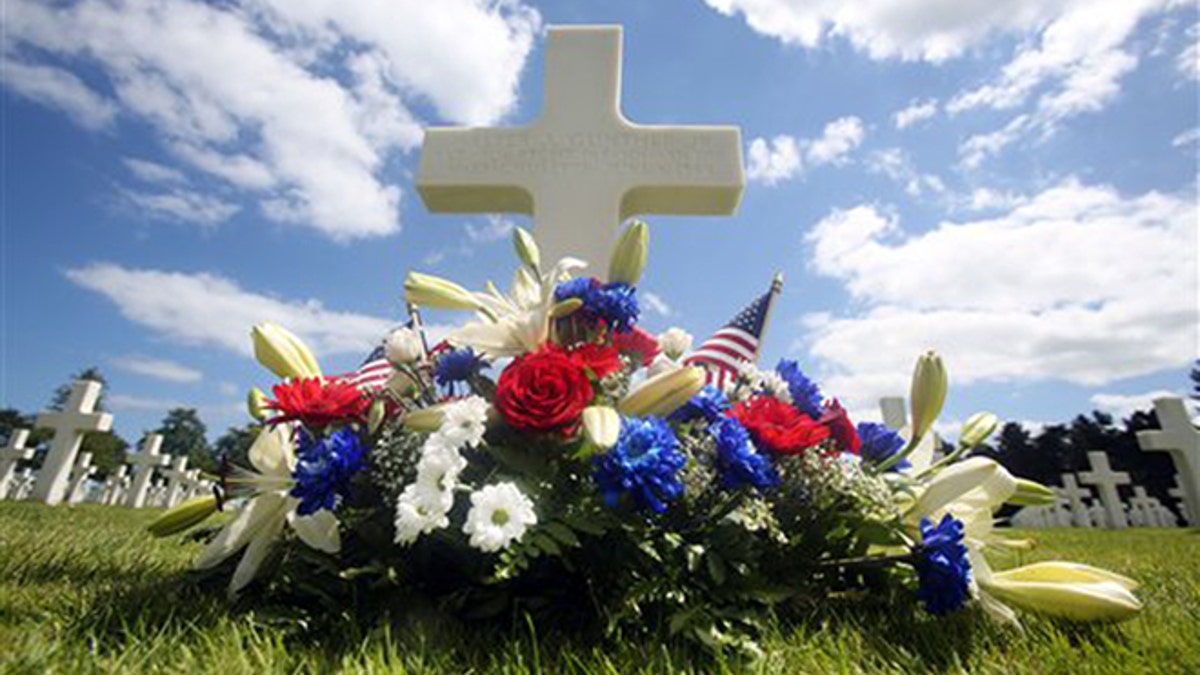
A wreath on the grave of Walter J. Gunther Jr, from the Massachusetts 101 airborn division, who died on June 6, 1944, at the Colleville American military cemetery, in Colleville sur Mer, western France, Saturday June 6, 2015, on the 71st anniversary of the D-Day landing. (AP Photo/Remy de la Mauviniere)
The 71st anniversary of World War II’s D-Day invasion was remembered Saturday at a cemetery in France overlooking Omaha Beach and, closer to home, by U.S. vets who bore witness to the horrors of “The Longest Day.”
Jacob Cutler, of Long Island, told Newsday the passage of time had made it easier for him to share his experiences as a private clinging to the base of a cliff on Omaha under withering German fire.
“We literally had to zigzag around the bodies, there were so many of them,” the 91-year-old Cutler said.
He told the paper he stands in awe of what was achieved by the 156,000 Allied troops sent ashore on D-Day on the beaches of Normandy.
“We were 19, 20, 21 years old, kids sent to war,” Cutler said. “But we did the job.”
As Cutler was being interviewed, allied veterans and families of fallen comrades gathered at the Normandy American Cemetery in Colleville-sur-Mer, amid the thousands of white marble crosses and Stars of David of servicemen and women who lost their lives during the invasion.
Visitors and cadets from the United States Naval Academy in Annapolis, Maryland, bowed their heads during the cemetery’s D-Day remembrance and stood silently during a parade of bagpipers.
Another D-Day commeration took place Saturday at another Normandy landmark not far away, the Cathedral Bayeux. There British serviceman stood shoulder to shoulder to remember fallen comrades at an event organized by the Royal British Legion.
British Chaplain Patrick Irwin told the old veterans “we thank you from the bottom of our hearts,” BT.com reported.
“Your historic achievements will remain as one of the defining moments in the history of the last century,” Irwin said.
As bells tolled following the service, British D-Day veteran Victor Mackenzie, 91, told the website “it’s always very emotive. It really is.”
“You have to think of those who never came back,” he added. “It’s with you every day. It’s one of those things. Coming back to the cathedral brings back so many memories.”
The number of Allied troops who died on D-Day was 4,413, including 2,499 Americans, as tallied by the D-Day Museum in England.
The invasion began shortly after midnight on June 6, 1944, with a perilous airborne operation led by paratroopers of the "Screaming Eagles" 101st Airborne and the 82nd Airborne divisions.
At dawn, thousands of Allied troops leaped out of landing craft to storm the beaches under ferocious German attacks.
Russ Snell, of Desert Edge, Calif., was a participant in the airborne invasion as a paratrooper with the Company C of the 506th Parachute Infantry Regiment.
In an interview with the Desert News, the 91-year-old recalled how he sat in the belly of a C-47 military transport plane, waiting in silence for the order to jump about five miles inland, west of Utah Beach.
“When the flak came up and you heard it, you wanted to get out of that plane,” Snell said. “It was like it hailed outside. That’s why you’re glad to jump. When those planes go down, that’s it. But when you jump, you still have a chance.”
He parachuted into pitch darkness, the only illumination the tracers from the ground fire.
“It was all a surprise—2 o’clock in the morning and it was the first jump you make in combat,” he told the paper.
A week after D-Day, Snell was shot in the arm and hospitalized. After his discharge, he was back in action and fought in the Battle of Bulge, surviving another historic battle that altered the course of history.
The Associated Press contributed to this report.

